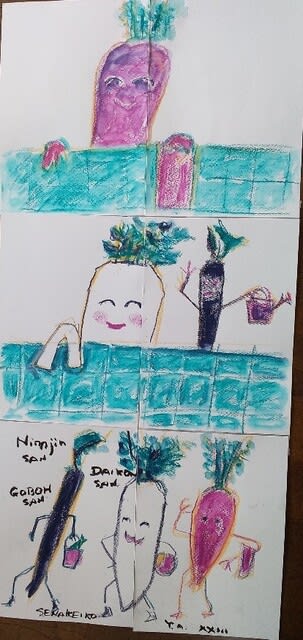朝日記240325 2.( その7) 解説ABM(Agent-Based-Method)報文XVI( その7)
朝日記240325 2.(表紙 その1) 解説ABM(Agent-Based-Method)報文XVI(表紙 その1)
General
- Barnes, D.J.; Chu, D. (2010). Introduction to Modelling for Biosciences (chapter 2 & 3). Springer Verlag. ISBN 978-1-84996-325-1. Archived from the original on December 30, 2010. Retrieved September 20, 2010.
- Carley, Kathleen M. "Smart Agents and Organizations of the Future". In Lievrouw, Leah; Livingstone, Sonia (eds.). Handbook of New Media. Thousand Oaks, CA: Sage. pp. 206–220. Archived from the original on June 11, 2007. Retrieved February 17, 2008.
- Farmer, J. Doyne; Foley, Duncan (August 6, 2009). "The economy needs agent-based modelling". Nature. 460 (7256): 685–686. Bibcode:2009Natur.460..685F. doi:10.1038/460685a. PMID 19661896. S2CID 37676798. Archived from the original on July 25, 2020. Retrieved June 28, 2019.
- Gilbert, Nigel; Troitzsch, Klaus (2005). Simulation for the Social Scientist (2 ed.). Open University Press. ISBN 978-0-335-21600-0. first edition, 1999.
- Gilbert, Nigel (2008). Agent-based Models. SAGE. ISBN 9781412949644.
- Helbing, Dirk; Balietti, Stefano. Helbing, Dirk (ed.). "Agent-Based Modeling". Social Self-Organization: 25–70.
- Holland, John H. (1992). "Genetic Algorithms". Scientific American. 267 (1): 66–72. Bibcode:1992SciAm.267a..66H. doi:10.1038/scientificamerican0792-66.
- Holland, John H. (September 1, 1996). Hidden Order: How Adaptation Builds Complexity (1 ed.). Reading, Mass.: Addison-Wesley. ISBN 978-0-201-44230-4.
- Miller, John H.; Page, Scott E. (March 5, 2007). Complex Adaptive Systems: An Introduction to Computational Models of Social Life. Princeton, NJ: Princeton University Press. ISBN 978-0-691-12702-6.
- Murthy, V. K.; Krishnamurthy, E. V. (2009). "Multiset of Agents in a Network for Simulation of Complex Systems". Recent Advances in Nonlinear Dynamics and Synchronization. Studies in Computational Intelligence. Vol. 254. p. 153. doi:10.1007/978-3-642-04227-0_6. ISBN 978-3-642-04226-3.
- Naldi, G.; Pareschi, L.; Toscani, G. (2010). Mathematical modeling of collective behavior in socio-economic and life sciences. Birkhauser. ISBN 978-0-8176-4945-6. Archived from the original on September 1, 2012. Retrieved August 28, 2017.
- Onggo, B.S.; Karatas, M. (2016). "Test-driven simulation modelling: A case study using agent-based maritime search-operation simulation". European Journal of Operational Research. 254 (2): 517–531. doi:10.1016/j.ejor.2016.03.050. Archived from the original on June 30, 2020. Retrieved March 30, 2021.
- O'Sullivan, D.; Haklay, M. (2000). "Agent-based models and individualism: Is the world agent-based?". Environment and Planning A (Submitted manuscript). 32 (8): 1409–1425. doi:10.1068/a32140. S2CID 14131066. Archived from the original on February 4, 2023. Retrieved October 28, 2018.
- Preis, T.; Golke, S.; Paul, W.; Schneider, J. J. (2006). "Multi-agent-based Order Book Model of financial markets". Europhysics Letters (EPL). 75 (3): 510–516. Bibcode:2006EL.....75..510P. doi:10.1209/epl/i2006-10139-0. S2CID 56156905.
- Rudomín, I.; Millán, E.; Hernández, B. N. (November 2005). "Fragment shaders for agent animation using finite state machines". Simulation Modelling Practice and Theory. 13 (8): 741–751. doi:10.1016/j.simpat.2005.08.008.
- Salamon, Tomas (2011). Design of Agent-Based Models : Developing Computer Simulations for a Better Understanding of Social Processes. Bruckner Publishing. ISBN 978-80-904661-1-1. Archived from the original on March 17, 2012. Retrieved October 22, 2011.
- Sallach, David; Macal, Charles (2001). "The simulation of social agents: an introduction". Social Science Computer Review. 19 (33): 245–248. doi:10.1177/089443930101900301. S2CID 219971440.
- Shoham, Yoav; Leyton-Brown, Kevin (2009). Multiagent Systems: Algorithmic, Game-Theoretic, and Logical Foundations. Cambridge University Press. p. 504. ISBN 978-0-521-89943-7. Archived from the original on May 1, 2011. Retrieved February 25, 2009.
- Vidal, Jose (2010). "Fundamentals of Multiagent Systems Using NetLogo" (PDF). Archived (PDF) from the original on March 31, 2020. Retrieved May 31, 2020. Available online.
- Wilensky, Uri; Rand, William (2015). An Introduction to Agent-Based Modeling: Modeling Natural, Social, and Engineered Complex Systems with NetLogo. MIT Press. ISBN 978-0-2627-3189-8. Archived from the original on June 8, 2020. Retrieved May 3, 2020.
- Sabzian, Hossein; Shafia, Mohammad Ali (2018). "A review of agent-based modeling (ABM) concepts and some of its main applications in management science". Iranian Journal of Management Studies. 11 (4): 659–692. Archived from the original on April 24, 2021. Retrieved April 7, 2021.
External links
Articles/general information
- Agent-based models of social networks, java applets.
- On-Line Guide for Newcomers to Agent-Based Modeling in the Social Sciences
- Introduction to Agent-based Modeling and Simulation. Argonne National Laboratory, November 29, 2006.
- Agent-based models in Ecology – Using computer models as theoretical tools to analyze complex ecological systems[permanent dead link]
- Network for Computational Modeling in the Social and Ecological Sciences' Agent Based Modeling FAQ
- Multiagent Information Systems – Article on the convergence of SOA, BPM and Multi-Agent Technology in the domain of the Enterprise Information Systems. Jose Manuel Gomez Alvarez, Artificial Intelligence, Technical University of Madrid – 2006
- Artificial Life Framework
- Article providing methodology for moving real world human behaviors into a simulation model where agent behaviors are represented
- Agent-based Modeling Resources, an information hub for modelers, methods, and philosophy for agent-based modeling
- An Agent-Based Model of the Flash Crash of May 6, 2010, with Policy Implications, Tommi A. Vuorenmaa (Valo Research and Trading), Liang Wang (University of Helsinki - Department of Computer Science), October, 2013
Simulation models
- Multi-agent Meeting Scheduling System Model by Qasim Siddique
- Multi-firm market simulation by Valentino Piana
- List of COVID-19 simulation models
- This page was last edited on 23 August 2023, at 02:50 (UTC).
- Text is available under the Creative Commons Attribution-ShareAlike License 4.0; additional terms may apply. By using this site, you agree to the Terms of Use and Privacy Policy. Wikipedia® is a registered trademark of the Wikimedia Foundation, Inc., a non-profit organization.
- Privacy policy
- About Wikipedia
- Disclaimers
- Contact Wikipedia
- Code of Conduct
- Mobile view
- Developers
- Statistics
- Cookie statement




















